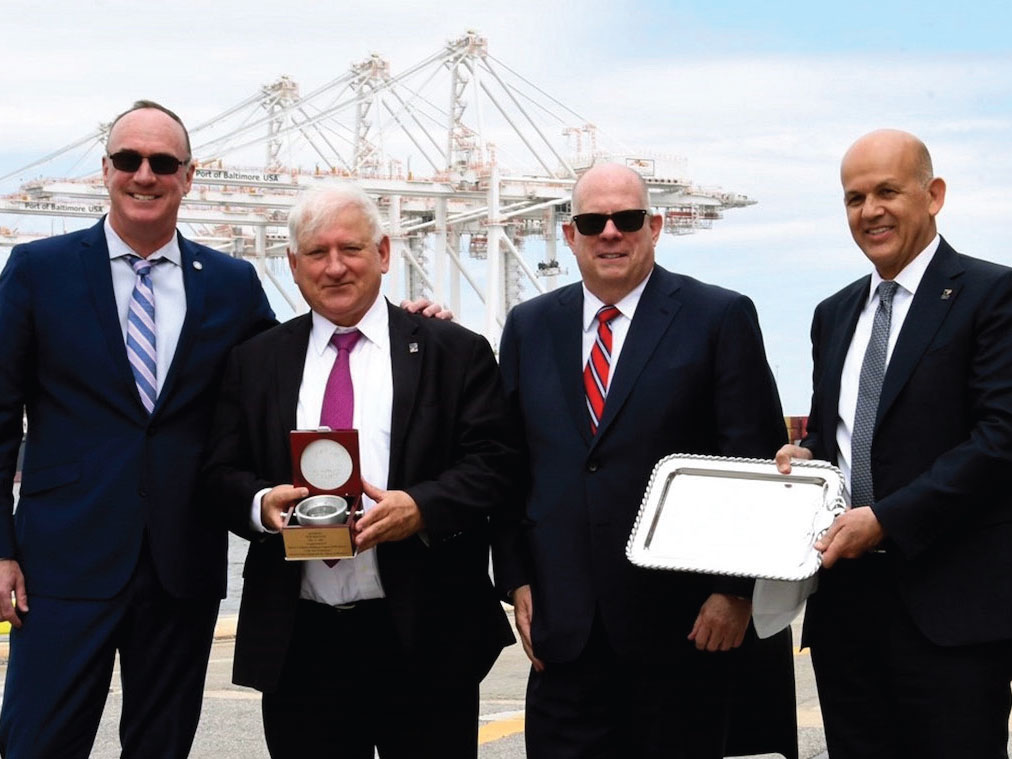With expanded global service offerings and completion of a second 50-foot-draft berth, plus commencement of the much-anticipated Howard Street Tunnel project, the Helen Delich Bentley Port of Baltimore is enhancing its position as a favored East Coast hub for e-commerce and other trade.
This year’s collaborative start on the $466 million tunnel endeavor is likely the biggest advance as, upon projected 2025 completion, rail cars double-stacked with containers should be able to move freely to and from the Port of Baltimore, reaching markets in the Midwest, as well as up and down the entire U.S. East Coast.
According to MPA officials, the completed tunnel project is expected to add about 160,000 containers a year to the Port of Baltimore’s cargo flow.
Most recently, the Maryland Port Administration announced receipt of $15.6 million in federal funding for intermodal rail improvements at the Port of Baltimore’s Seagirt Marine Terminal – a project further supporting increases in rail moves. (See separate story on the next column of this page)
Complementing the tunnel undertaking is the $166 million expansion of big-ship-handling capabilities at the Seagirt terminal by operator Ports America Chesapeake. Completion in late 2021 of a second 50-foot-draft berth allows simultaneous accommodation of multiple megacontainerships at the Seagirt facility, where four additional neo-Panamax ship-to-shore cranes entered service this year.
The Ports America unit, which embarked in 2009 upon a $1.3 billion, 50-year concession agreement with the MPA, also is investing in hybrid-electric container-handling equipment, a state-of-industry truck gate complex, a relocated container repair depot and software and technology upgrades at the Seagirt facility.
At Seagirt, the latest service addition got under way in May, with Israel-headquartered ZIM Integrated Shipping Services Ltd. inaugurating its aptly monikered ZIM E-Commerce Baltimore Express (ZXB) from China and Southeast Asia. The service is poised to soon increase frequency to weekly from its initial biweekly basis.

“ZIM’s new e-commerce-centric service is outstanding news for the Port of Baltimore and our International Longshoremen’s Association labor force,” said MPA Executive Director William P. Doyle. “ZIM is one of the top ocean carriers in the world, and we’re pleased to welcome them to Baltimore.
“With our additional ultralarge neo-Panamax cranes, our future double-stack rail capabilities and an incredible network of regional distribution, fulfillment and sorting centers, Baltimore is extremely well-positioned to continue growing our container business and serving as No. 1 e-commerce port in the nation,” Doyle added, going on to note the port’s propitious location along the Interstate 95 corridor and its situation as the East Coast’s closest inland port to the Midwest.
The new ZIM offering comes on the heels of starts of a pair of further container services calling the Port of Baltimore – Maersk Line’s TP20 string, from China and Southeast Asia, and Mediterranean Shipping Co.’s Indus 2 service, which begins in India and transits the Suez Canal to Italy and Portugal before heading to the U.S. East Coast.
The new services and infrastructural enhancements could not be coming at a more opportune time, according to Doyle.
“The Port of Baltimore has not experienced the supply chain issues that other ports have faced,” Doyle said. “In fact, we have helped the supply chain crisis by welcoming nearly 50 ‘ad hoc’ ship calls during the recovery stages of the pandemic – vessels diverted to Baltimore that were not on a regularly scheduled service call.
“There is a need for utilization of more gateways such as Baltimore to land cargo in the United States,” he continued. “Import/export demand for containerized cargo has substantially increased over the past year. With that demand, port congestion is at an all-time high. Baltimore is a prime gateway for goods heading to the e-commerce market and for cargo sent to the Midwest via rail.”
Beyond the container-focused Seagirt terminal, the MPA is moving forward with reconstruction and reinforcement of roll-on/roll-off berths at Dundalk Marine Terminal to allow for handling of larger, heftier farm and construction machinery at the leading U.S. facility for such cargos, as well as automobiles and light trucks.
Once complete by late 2023, the upgraded Dundalk installation, with significant removal of weight restrictions, should be able to handle a variety of still-heavier project and breakbulk cargos, according to Bill Wade, Baltimore director of operations for Ceres Marine Terminals Inc., terminal operator at the Dundalk facility.
The improvements are coming at a time when an increasing number of shippers, including those moving smaller rolling stock units, are opting for ro/ro transport as an alternative to containers, Wade noted. The Ceres operation is maintaining swift truck turn times of typically about 30 minutes to keep cargo moving.
“We’re customer-oriented and customer-driven, working with labor to safely, efficiently accommodate any special requirements of shippers, such as offering extended hours and providing services to prepare cargo for export,” Wade told AJOT.
“We work closely with steamship lines and OEMs [original equipment manufacturers] to make sure quality initiatives are being realized while always looking for opportunities to improve both quality and safety,” he added.
On the environmental front, the MPA project to use dredged material to restore a pair of vanishing islands off the coast of Maryland’s Dorchester County got a big boost with U.S. Army Corps of Engineers allocation of $37.5 million, ensuring construction of the Mid-Chesapeake Bay Island Ecosystem Restoration. Also earlier this year, the Port of Baltimore received a $1.8 million U.S. Environmental Protection Agency grant toward equipment upgrades – including bringing the port its first electric-powered dray trucks – that should help in achievement of significant emissions reductions.




